Ha Giang Loop Vietnam: The Definitive Guide
Welcome to the Ha Giang Loop – Vietnam’s most breathtaking motorcycle adventure.
This isn’t just another pretty drive. The Ha Giang Loop is a 350-kilometer journey through Vietnam’s final frontier – a place where landscapes defy imagination and cultures remain beautifully preserved against the tide of modernization.
But here’s the thing: this incredible adventure requires proper planning.
Whether you’re wondering about the best time to visit, how to rent a motorbike, or which villages to explore, I’ve got you covered. This guide contains everything you need to plan an unforgettable Ha Giang Loop adventure.
Let’s dive in!
Chapter 1:
Understanding the Ha Giang Loop: What, Where, and Why
Picture this: winding roads hugging limestone peaks, misty valleys stretching into the horizon, and the thrill of riding through Vietnam’s most breathtaking landscapes.
In this chapter, you’ll discover:
- What the Ha Giang Loop is and why it’s a must-do for adventure seekers
- Where it’s located and how to navigate the route
- Why it’s the ultimate bucket-list experience in Vietnam
Scroll down and let’s dive in!
What is the Ha Giang Loop?
The Ha Giang Loop is a circular motorcycle route spanning approximately 350-400 kilometers through Vietnam’s northernmost province. It’s not an official route with signs, but rather a traveler-established path that connects several mountain towns and villages through some of Asia’s most dramatic landscapes.
Typically taking 3-5 days to complete, the loop winds through towering karst mountains, deep valleys, terraced rice fields, and remote ethnic minority villages. The journey begins and ends in Ha Giang City, taking riders through key towns including Yen Minh, Dong Van, and Meo Vac.
While motorcycle travel is the most popular way to experience the loop, alternatives exist for non-riders (more on that later).
The loop gained popularity among adventure travelers around 2015 but remains relatively uncrowded compared to other Southeast Asian destinations. This balance of accessibility and authenticity is what makes the Ha Giang Loop Vietnam’s premier mountain adventure.
Where is the Ha Giang Loop Located?
Ha Giang province sits in Vietnam’s far north, sharing a 270-kilometer border with China’s Yunnan province. The loop itself winds through the northeastern section of Ha Giang province, approximately 300 kilometers north of Hanoi.
This remote region is characterized by the Dong Van Karst Plateau, a UNESCO-recognized geopark featuring dramatic limestone formations. The loop passes through several districts including Quan Ba, Yen Minh, Dong Van, and Meo Vac, with elevations ranging from 800-1,600 meters above sea level.
The province’s isolation and rugged terrain have historically limited development, preserving both natural landscapes and cultural traditions. This remoteness is part of what makes the journey so special.

Why the Ha Giang Loop Deserves Your Bucket List
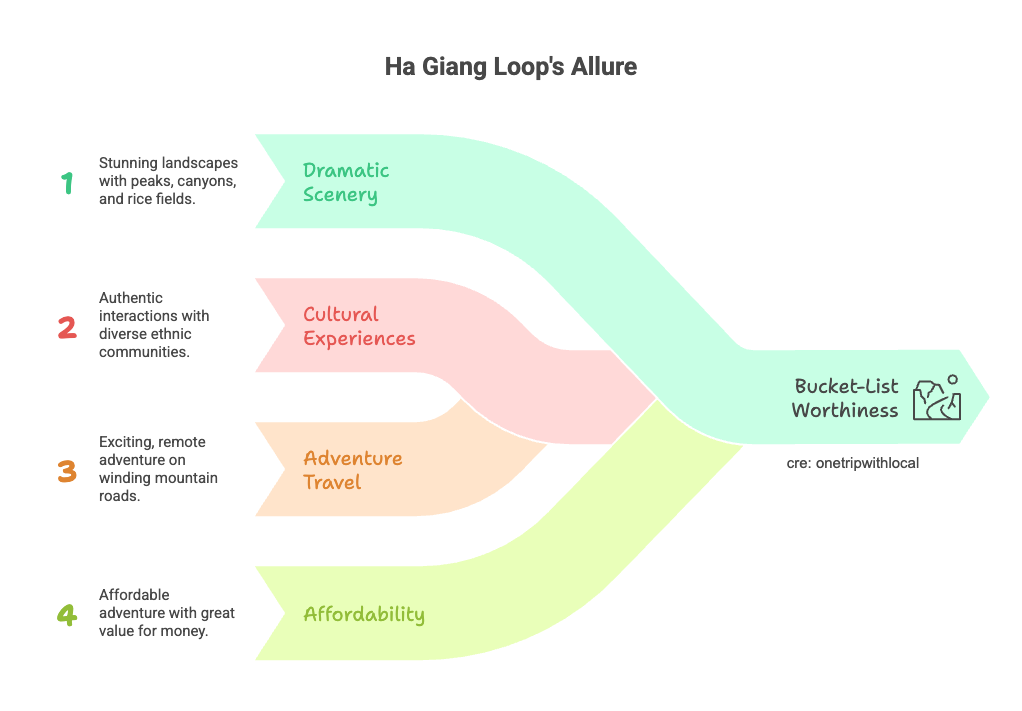
Unparalleled Scenery and Landscapes
The Ha Giang Loop offers Vietnam’s most dramatic mountain scenery – period. The landscape features jagged limestone peaks, deep canyons, terraced rice fields, and winding rivers.
The crown jewel is Ma Pi Leng Pass – often called the “King of Vietnamese Passes.” Here, the road clings to cliff faces overlooking the emerald Nho Que River nearly 800 meters below. This section alone justifies the entire journey.
Other spectacular viewpoints include Heaven’s Gate Pass in Quan Ba with its “fairy bosom” twin mountains, and the panoramic vistas from Lung Cu Flag Tower, marking Vietnam’s northernmost point.
Unlike the organized terraces of Sapa or the karst formations of Ninh Binh, Ha Giang’s landscapes feel wild and untamed. The scale is immense, the views uninterrupted, and the feeling of remoteness profound.
Authentic Cultural Experiences
Ha Giang province is home to more than 20 ethnic minority groups, including the Hmong, Dao, Tay, and Lo Lo peoples. These communities maintain distinct languages, architectural styles, clothing, and traditions.
The Sunday Market in Dong Van offers an authentic glimpse into local life as minority groups from surrounding villages gather to trade goods and socialize. The colorful traditional clothing isn’t for tourists – it’s everyday attire.
Homestays in traditional houses provide immersive cultural experiences. You might find yourself helping prepare dinner, learning about medicinal plants, or participating in evening music sessions with your host family.
What makes these experiences special is their authenticity. Unlike more developed tourist areas, cultural experiences in Ha Giang aren’t performances – they’re genuine interactions with communities continuing centuries-old ways of life.
Adventure and Off-the-Beaten-Path Travel
The Ha Giang Loop offers the perfect balance of adventure and accessibility. The winding mountain roads with their hairpin turns and dramatic drops provide exhilarating riding. You’ll feel like you’re discovering each vista for the first time.
Despite growing popularity, you’ll still find yourself alone on many stretches of road. In villages away from the main route, you might be the only foreigner. This feeling of exploration is increasingly rare in Southeast Asia.
As one traveler put it: “After years of traveling through Vietnam, the Ha Giang Loop made me feel like I was truly discovering something again, not just following a well-worn tourist path.”
A Great Bang for Your Buck
Vietnam already offers excellent value for travelers, and Ha Giang is no exception. A comprehensive 3-day loop can cost as little as $200-300, including motorcycle rental, accommodation, food, and activities.
Homestays typically cost $10-15 per night including breakfast and dinner. Local meals run $2-5. Motorcycle rental averages $10 per day. Even with guided tours, costs remain reasonable compared to similar adventures worldwide.
This accessibility means you can experience one of Asia’s greatest road trips without breaking the bank.

Chapter 2:
Planning Your Ha Giang Loop Adventure
Timing, budget, and logistics—get these right, and your Ha Giang Loop journey will be unforgettable. This chapter covers everything you need to plan the perfect trip with confidence.
In this chapter, you’ll learn:
- The best time to visit for ideal weather and stunning views
- How to choose the perfect duration for your trip (3, 4, or more days)
- The best ways to get to Ha Giang from Hanoi and beyond
- Budgeting tips to make the most of your adventure without overspending
Review the key details, fine-tune your itinerary, and get ready for an epic ride. Let’s dive in!
1. Best Time to Visit the Ha Giang Loop
Choosing the right season significantly impacts your Ha Giang experience. Here’s a monthly breakdown:
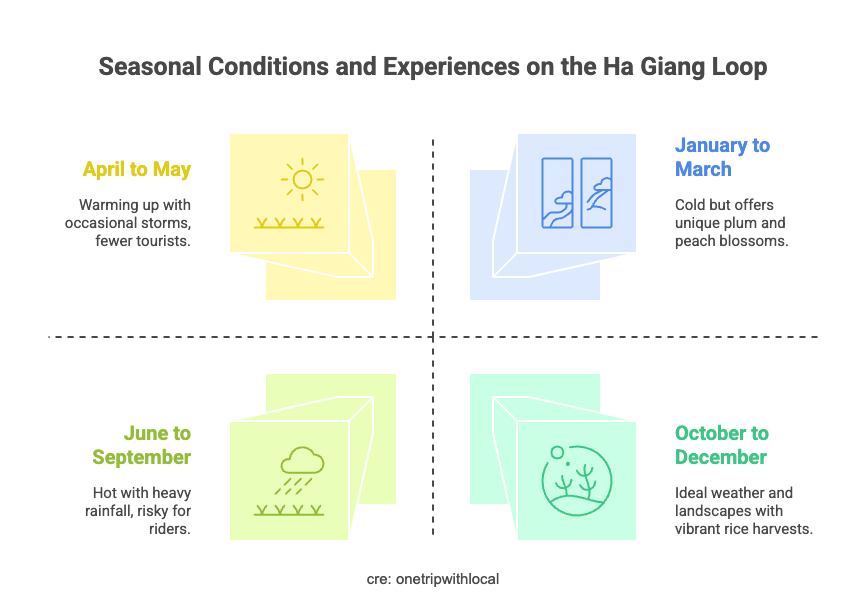
October to December (High Season)
- Weather: Clear skies, moderate temperatures (15-25°C/59-77°F), minimal rain
- Landscapes: Vibrant with rice harvest (October) and buckwheat flowers (October-November)
- Conditions: Optimal road conditions, excellent visibility
- Considerations: Busiest period, advance booking recommended
January to March
- Weather: Cold (5-15°C/41-59°F), often foggy, occasional light rain
- Landscapes: Misty mountains, plum and peach blossoms (February-March)
- Conditions: Potentially icy at higher elevations
- Considerations: Warm clothing essential, reduced visibility possible
April to May
- Weather: Warming up (15-28°C/59-82°F), occasional storms
- Landscapes: Green season begins, terraced fields being prepared
- Conditions: Generally good, occasional rainfall
- Considerations: Good alternative to peak season with fewer tourists
June to September (Rainy Season)
- Weather: Hot (25-35°C/77-95°F), heavy rainfall, potential flooding
- Landscapes: Lushest period, vibrant green terraces
- Conditions: Muddy roads, landslide risk
- Considerations: Most challenging period, experienced riders only
Photography opportunities by season:
- October-November: Buckwheat flower fields (purple/pink)
- September-October: Golden rice terraces
- February-March: Plum and peach blossoms
- June-August: Emerald green terraces
My recommendation: Mid-October to early December offers the ideal combination of comfortable weather, beautiful landscapes, and good road conditions. If you don’t mind cooler temperatures, February-March provides a less crowded alternative with unique spring blossoms.
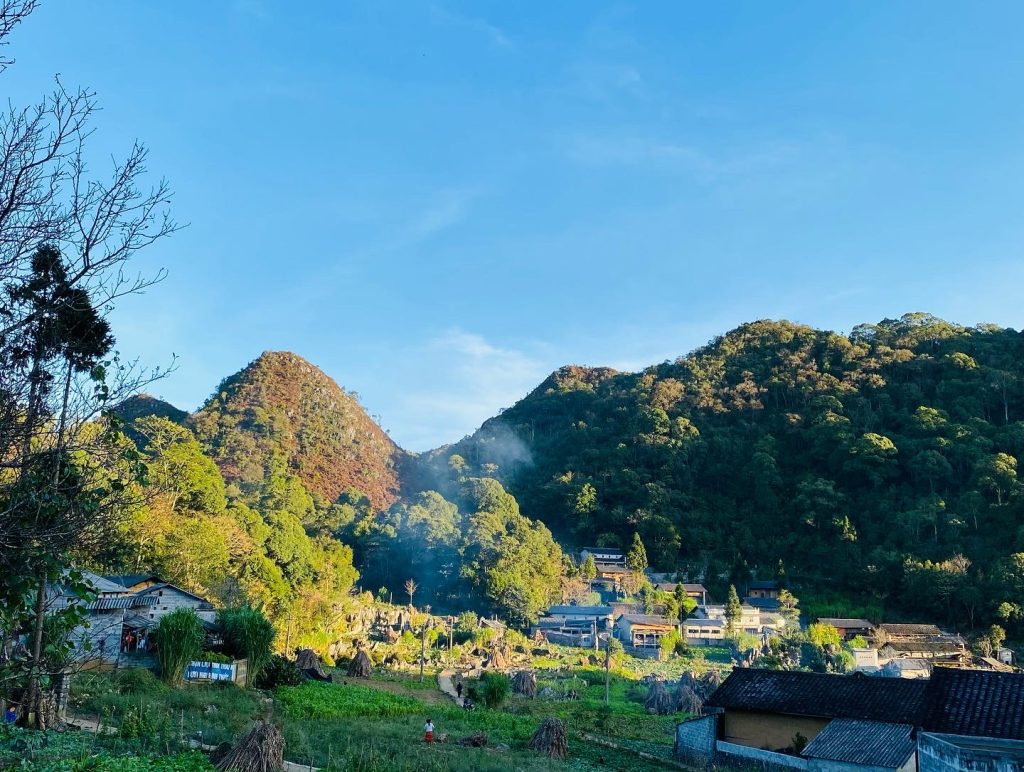
2. How Many Days for the Ha Giang Loop? Duration Options
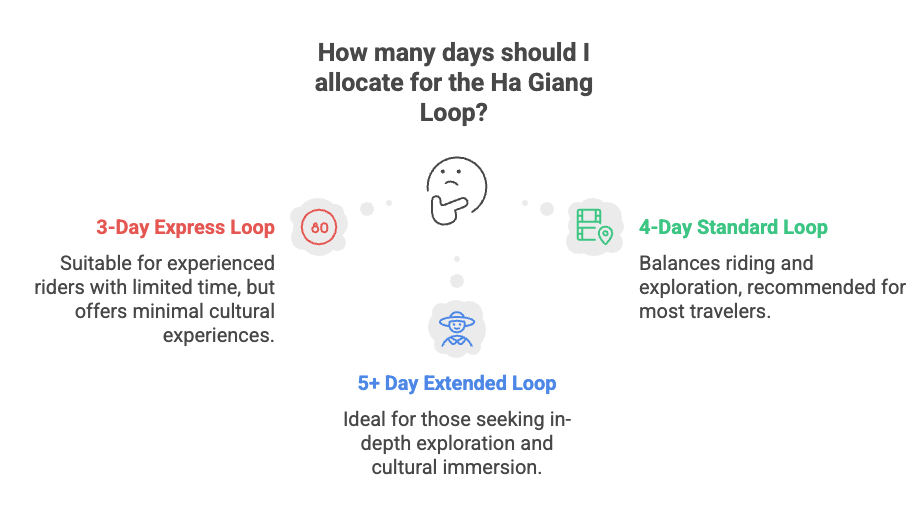
The ideal duration depends on your riding experience, interests, and pace preference. Here are your options:
3-Day Express Loop (Minimum Viable Duration)
- Daily distance: 120-150km (5-7 hours riding)
- Pace: Rushed, minimal stops
- Suitable for: Experienced riders with limited time
- Limitations: Little time for cultural experiences, photography, or exploration
- Recommendation: Only choose this if absolutely time-constrained
4-Day Standard Loop (Recommended)
- Daily distance: 80-100km (4-5 hours riding)
- Pace: Balanced, allowing for major attractions
- Suitable for: Most travelers, balance of riding and exploring
- Benefits: Time for key viewpoints, some village exploration
- Sample itinerary: Ha Giang → Yen Minh → Dong Van → Meo Vac → Ha Giang
5+ Day Extended Loop (Ideal)
- Daily distance: 60-80km (3-4 hours riding)
- Pace: Relaxed, abundant exploration time
- Suitable for: Photography enthusiasts, cultural immersion seekers
- Benefits: Off-the-beaten-path detours, deeper cultural experiences
- Recommended additions: Lung Ho village, Lung Cu tower, Du Gia
Factors affecting your decision:
- Riding experience: Less experienced riders should opt for more days
- Weather conditions: Rainy periods require slower riding
- Photography interests: Serious photographers benefit from extra time
- Physical comfort: More days mean less saddle soreness
Remember that the Ha Giang Loop isn’t a race. Having buffer time allows for spontaneous discoveries, which often become trip highlights.
3. Getting to Ha Giang: Transportation Guide
From Hanoi to Ha Giang City:

Sleeper Bus (Most Popular)
- Duration: 5-7 hours
- Cost: 250,000-350,000 VND ($10-15)
- Departure points: My Dinh or Gia Lam bus stations
- Recommended companies: Hai Van, Cau Me
- Booking options: Through your accommodation, via 12Go.Asia, or directly at bus stations
- Schedule: Multiple departures daily (7am, 9am, 1pm, 9pm, 11pm)
- Pro tip: Overnight buses (9pm, 11pm) save a hotel night but arrive very early (3-4am)
Private Car/Limousine Van
- Duration: 5-6 hours
- Cost: 1,500,000-2,500,000 VND ($65-110) per vehicle
- Benefits: Comfort, flexible departure, bathroom stops
- Booking: Through Hanoi hotels or online travel agencies
- Recommended for: Families, groups, those prone to motion sickness
Motorcycle (For Experienced Riders)
- Duration: 1-2 days
- Route options: Direct via Highway QL2 or scenic via Thac Ba Lake
- Considerations: Challenging ride, highway traffic
- Not recommended for inexperienced riders
Train + Bus Connection
- Route: Train to Lao Cai + bus to Ha Giang
- Duration: 10-12 hours total
- Benefit: Can combine with Sapa visit
- Drawback: Time-consuming, multiple transfers
Check out: Hanoi to Ha Giang Vietnam: Transport Guide
4. Ha Giang Loop Budget Planning
How much does the Ha Giang Loop cost? Here’s a comprehensive breakdown:
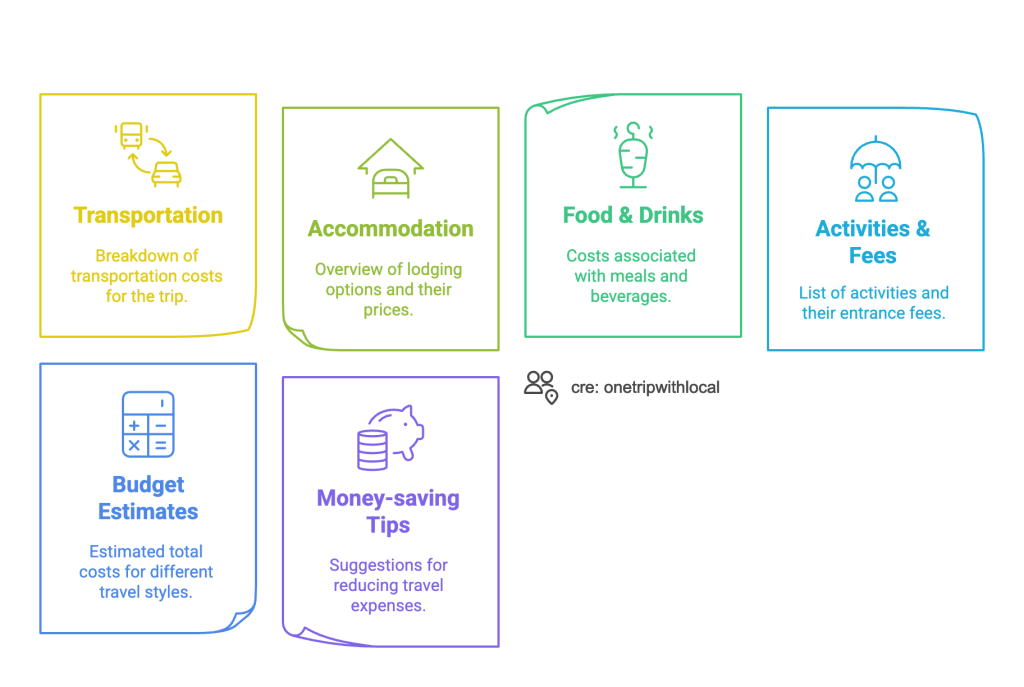
Transportation
- Hanoi to Ha Giang (round-trip): 500,000-700,000 VND ($22-30) by sleeper bus
- Motorcycle rental: 200,000-400,000 VND ($9-17) per day
- Semi-automatic: 200,000-250,000 VND ($9-11)
- Automatic scooter: 250,000-300,000 VND ($11-13)
- Manual motorcycle: 300,000-400,000 VND ($13-17)
- Fuel: 100,000-150,000 VND ($4-7) for entire loop
- Permit fee: 210,000 VND ($9) per person
Accommodation
- Budget homestay: 150,000-250,000 VND ($7-11) per person
- Standard homestay: 250,000-350,000 VND ($11-15) per person
- Guesthouse/hotel: 350,000-700,000 VND ($15-30) per room
- Most homestays include dinner and breakfast
Food & Drinks
- Local meal: 40,000-80,000 VND ($2-3.50)
- Western meal: 80,000-150,000 VND ($3.50-6.50)
- Street food snack: 15,000-30,000 VND ($0.65-1.30)
- Beer: 15,000-30,000 VND ($0.65-1.30)
- Coffee: 15,000-40,000 VND ($0.65-1.75)
- Water: 10,000-20,000 VND ($0.45-0.90)
Activities & Entrance Fees
- Lung Cu Tower: 25,000 VND ($1.10)
- Heaven’s Gate viewpoint: Free
- Hmong King Palace: 20,000 VND ($0.90)
- Nho Que River boat ride: 100,000-150,000 VND ($4.50-6.50)
- Local guide (optional): 500,000-1,000,000 VND ($22-45) per day
Total Budget Estimates (per person, 4 days)
- Backpacker: 2,000,000-3,000,000 VND ($90-130)
- Standard: 3,000,000-4,500,000 VND ($130-200)
- Comfort: 4,500,000-6,000,000 VND ($200-260)
- Add 1,500,000-2,500,000 VND ($65-110) if taking Easy Rider tour
Money-saving tips:
- Most places accept cash only – bring Vietnamese Dong
- ATMs available in Ha Giang city but limited elsewhere
- Negotiate motorcycle rental for multi-day discounts
- Share rooms at guesthouses for better rates
- Eat where locals eat for better prices and authentic food
Chapter 3:
Experiencing the Ha Giang Loop: Tour vs. Self-Guided
Ready to conquer the Ha Giang Loop but not sure whether to ride solo or go with a guided tour? This chapter breaks down both options so you can choose the best way to experience Vietnam’s most breathtaking motorbike adventure.
Here’s what you’ll discover:
- The pros and cons of guided tours – including Easy Riders and tour packages
- How to rent a motorbike and ride the loop independently
- Alternative ways to explore Ha Giang if you don’t want to ride
Each option offers a unique experience—find the one that suits you best. Scroll down to discover your perfect way to ride!
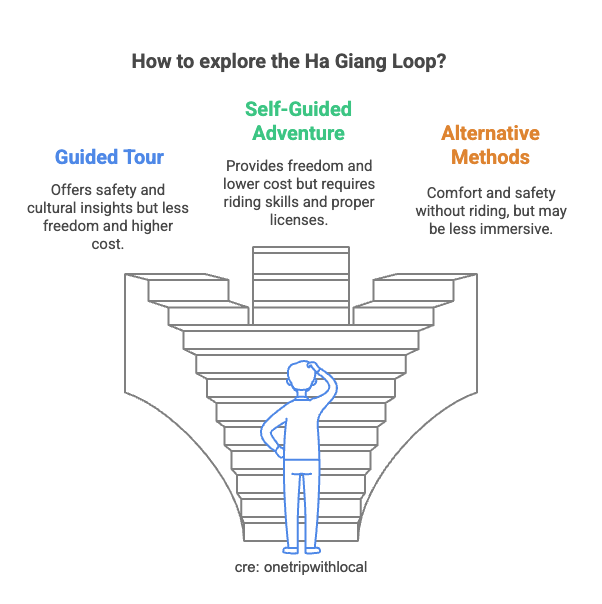
1. Guided Tour Options: Easy Riders and Tour Packages
Easy Rider Experience An Easy Rider tour means riding as a passenger behind an experienced local driver/guide who knows the roads intimately.
Benefits:
- Safety: Professional drivers familiar with challenging roads
- Cultural insights: Local guides provide context and translation
- No navigation stress: Focus entirely on the experience
- Interaction: Quality time with a local guide
- Legal advantage: No license requirements for passengers
Drawbacks:
- Higher cost: 1,500,000-2,500,000 VND ($65-110) per day
- Less freedom: Following guide’s schedule
- Physical closeness: Hours spent sitting behind a stranger
Reputable Easy Rider providers:
- QT Motorbikes & Tours: Professional operation, English-speaking drivers
- Flamingo Travel: Experienced guides, good reviews
- Ha Giang Motorbike Tours: Local knowledge, competitive prices
- Mr. Hung’s Homestay: Combines accommodation and Easy Rider services
Organized Group Tours For those preferring structured experiences with everything arranged:
Options:
- Small group tours: 4-8 people, more personalized
- Standard tours: 8-12 people, more economical
- Private tours: Customized itinerary, premium pricing
Pricing:
- 3-day tour: $180-250 per person
- 4-day tour: $220-320 per person
- 5-day tour: $280-380 per person
What’s typically included:
- Transportation from Hanoi
- Motorcycle and driver/guide
- Accommodation
- Most meals
- Entrance fees
- Permit processing
Recommended tour operators:
- Vietnam Backpacker Hostels: Popular with younger travelers
- Ethnic Travel: Focus on cultural experiences
- Indochina Junk: Premium tour options
- OneTrip: Good mid-range option
If you prefer exploring with expert guidance and want to understand the cultural context of what you’re seeing, consider booking a tour. However, if you’re visiting Hanoi first, our Stories from Vietnam War Tour offers fascinating historical context before your mountain adventure.
2. Self-Guided Adventure: Motorcycle Rental and Requirements
Can you do the Ha Giang Loop without a tour? Absolutely! Self-guided exploration is the most popular option, offering maximum freedom and adventure at the lowest cost.
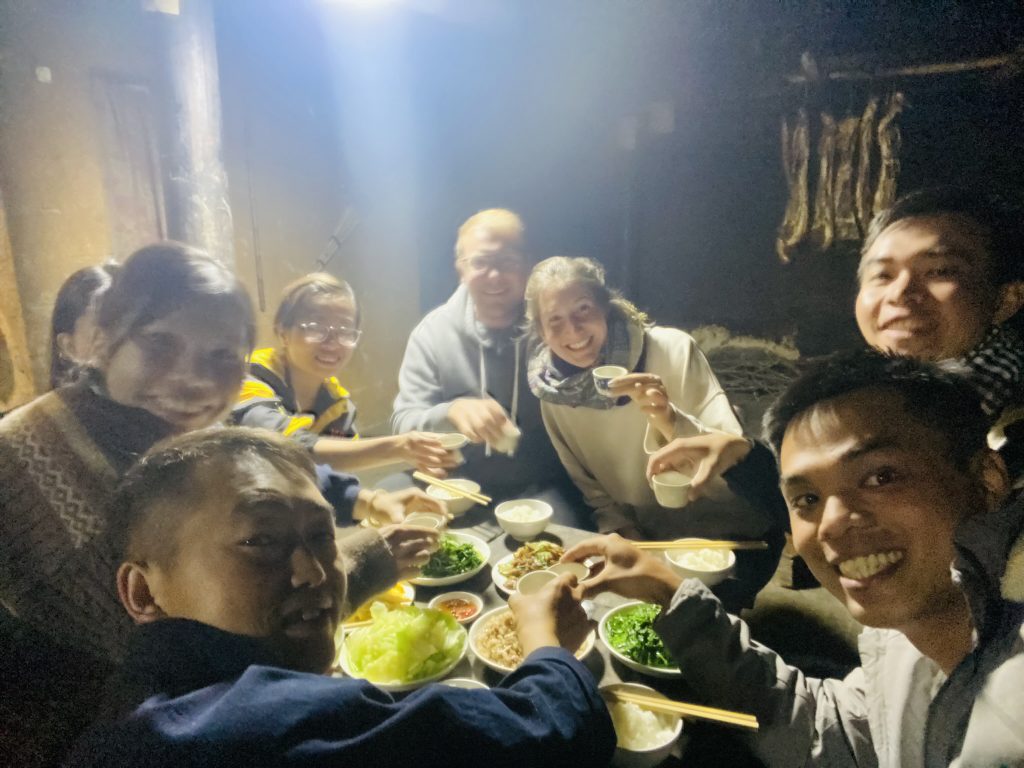
Motorcycle Rental Options
Ha Giang City has numerous rental shops. Recommended providers:
- QT Motorbikes: Largest selection, well-maintained fleet
- Jasmine Hostel: Good quality bikes, convenient location
- Ha Giang Hostel/Biker: Reliable options with hostel
- Rent a Bike Ha Giang: Competitive prices, helpful staff
Motorcycle types and daily costs:
- Semi-automatic (Honda Win/Bonus): 200,000-250,000 VND ($9-11)
- Automatic scooter (Honda Vision/Yamaha Nouvo): 250,000-300,000 VND ($11-13)
- Manual motorcycle (Honda XR150): 300,000-400,000 VND ($13-17)
What to expect when renting:
- Passport deposit or cash deposit (usually $200-300)
- Basic maintenance explanation
- Map and route suggestions
- Helmet included (quality varies)
- Basic insurance (covers bike damage, not medical)
License Requirements and Legal Considerations
Legal requirements:
- Vietnamese law requires an appropriate motorcycle license
- Foreign licenses must be converted to Vietnamese licenses
- International Driving Permits alone are technically not sufficient
Reality on the ground:
- Enforcement is inconsistent in Ha Giang province
- Most rental shops don’t require license verification
- Police checkpoints rarely check tourist licenses
- The border permit is more commonly checked than licenses
Insurance considerations:
- Most travel insurance policies won’t cover accidents if riding without proper license
- Consider additional motorcycle-specific insurance
- Always wear a helmet (required by law)
Essential Riding Skills for Mountain Roads
The Ha Giang Loop is not for novice riders. Required skills include:
- Confident braking: Managing steep descents
- Cornering technique: Navigating endless switchbacks
- Obstacle avoidance: Rocks, animals, potholes
- Weather adaptation: Riding in variable conditions
- Traffic navigation: Sharing narrow roads with trucks
If you’re new to motorcycling, consider:
- Taking a passenger position with an Easy Rider
- Practicing in Ha Giang city before departing
- Starting with shorter day trips
- Choosing an automatic scooter (easier for beginners)
Navigation Tools
Essential navigation resources:
- Maps.me: Offline maps with good detail
- Google Maps: Download offline areas before departing
- Vietnam Coracle: Detailed route description
- Physical map: Available from rental shops as backup
- GPS tracker: Optional but helpful
Remember that cell service is spotty throughout the loop, so offline navigation is crucial.
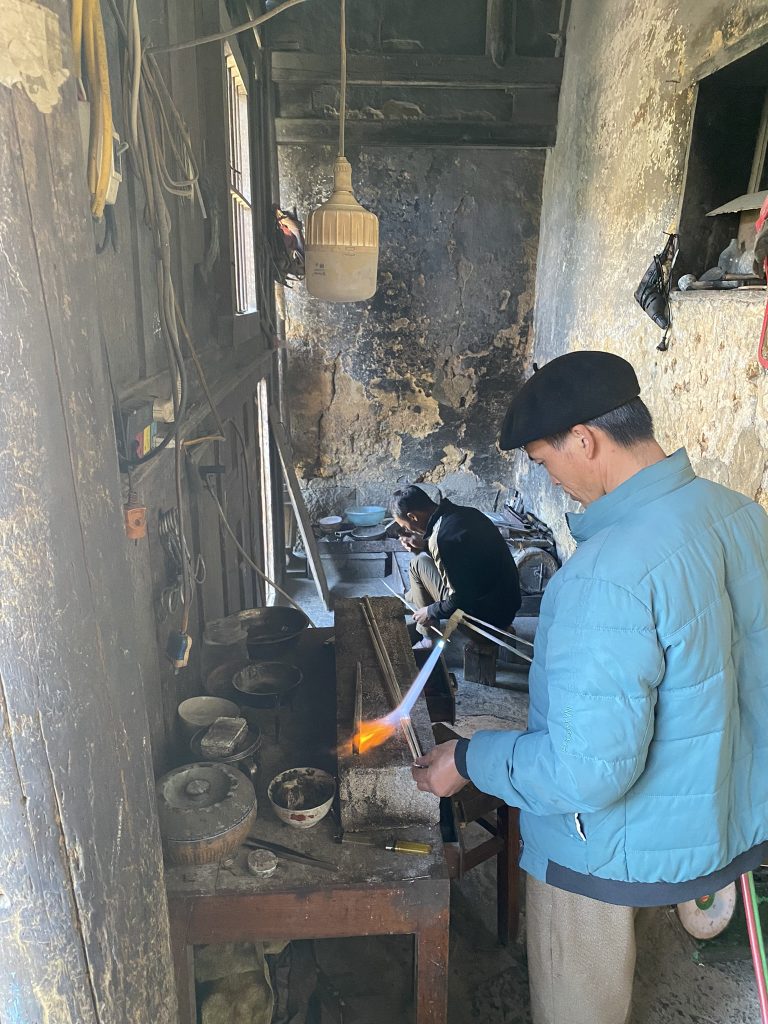
3. Alternative Exploration Methods for Non-Motorcyclists
Not comfortable on two wheels? You can still experience the Ha Giang Loop:
Private Car with Driver
- Cost: 1,800,000-2,500,000 VND ($80-110) per day
- Benefits: Comfort, safety, air conditioning
- Limitations: Less immersive, driver may have limited English
- Booking: Through hotels in Ha Giang or online agencies
- Recommendation: Request stops for photos and exploration
Jeep Tours
- Cost: 2,000,000-3,000,000 VND ($90-130) per day
- Benefits: Off-road capability, open-air experience
- Providers: QT Tours, Ha Giang Jeep Tours
- Group size: Usually 4-6 people per vehicle
- Experience: More adventurous than car, less than motorcycle
Shared Minivan Tours
- Cost: 800,000-1,200,000 VND ($35-55) per day
- Format: Hop-on/hop-off between major towns
- Benefits: Economical, social
- Limitations: Fixed schedule, crowded
- Booking: Through hostels or tourism offices
Hiking Sections + Transportation
- Approach: Base in towns and do day hikes
- Transportation: Local buses or pre-arranged transfers
- Benefits: Deeper nature immersion
- Limitation: Covers less distance overall
While motorcycling offers the most flexibility, these alternatives provide viable options for experiencing Ha Giang’s beauty safely and comfortably.
Chapter 4:
Ultimate Ha Giang Loop Itineraries
Whether you have three days or want to take your time with a longer adventure, planning the right itinerary is key to experiencing the Ha Giang Loop at its best. This chapter lays out the perfect routes based on your travel style, timeframe, and interests.
Inside, you’ll find:
- The Classic 3-Day Itinerary for a fast but unforgettable journey
- A Comprehensive 4-5 Day Route for a deeper, more relaxed experience
- Specialized itineraries for photographers, cultural explorers, and thrill-seekers
Get ready to map out your perfect ride. Let’s hit the road!
1. Classic 3-Day Ha Giang Loop Itinerary
This compact itinerary covers the essential highlights at a fast pace.
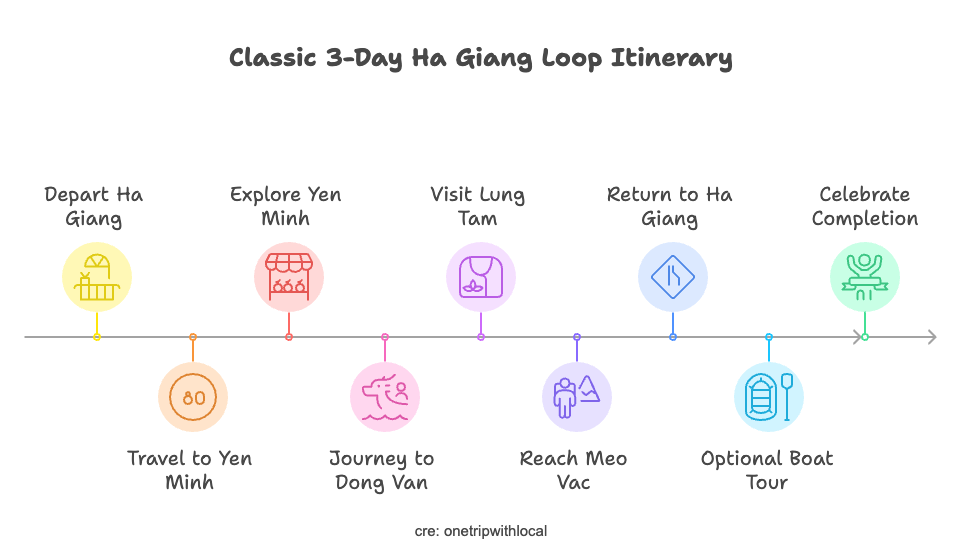
Day 1: Ha Giang to Yen Minh (100km, 4-5 hours)
- Morning: Depart Ha Giang by 8:30am
- Highlight: Heaven’s Gate Pass and Quan Ba viewpoint
- Stops:
- Tam Son town (coffee break)
- Twin Mountains viewpoint
- Nam Dam village (optional lunch)
- Afternoon: Continue to Yen Minh
- Accommodation: Thang Co Homestay or Rocky Plateau Hotel
- Difficulty: Moderate, good road conditions
- Evening: Explore Yen Minh market, dinner at homestay
Day 2: Yen Minh to Dong Van to Meo Vac (80km, 4-5 hours)
- Morning: Early start, head to Dong Van
- Stops:
- Lung Tam textile village
- Pho Bang ancient town
- Sa Phin Valley (Hmong King Palace)
- Lung Cu Flag Tower (17km detour)
- Lunch: Local restaurant in Dong Van Old Quarter
- Afternoon: Tackle Ma Pi Leng Pass to Meo Vac
- Highlight: Ma Pi Leng viewpoint, Nho Que River views
- Accommodation: Auberge de Meo Vac or local homestay
- Difficulty: Challenging, steep sections
- Evening: Explore Meo Vac, dinner options in town
Day 3: Meo Vac to Ha Giang (150km, 6-7 hours)
- Morning: Early departure
- Optional: Nho Que River boat tour (adds 1-2 hours)
- Stops:
- Khau Vai Love Market village
- Mau Due stone plateau
- Lunch: Local restaurant in Du Gia
- Afternoon: Long stretch back to Ha Giang
- Difficulty: Long day, varied road conditions
- Evening: Return rental bike, celebrate completion
Notes for 3-day itinerary:
- This is a rushed schedule – early starts are essential
- Pre-book accommodation to save time
- Limited time for extended village exploration
- Consider adding a fourth day for a more relaxed experience
2. Comprehensive 4-5 Day Ha Giang Loop Experience
This more relaxed itinerary allows deeper exploration and less rushed riding.
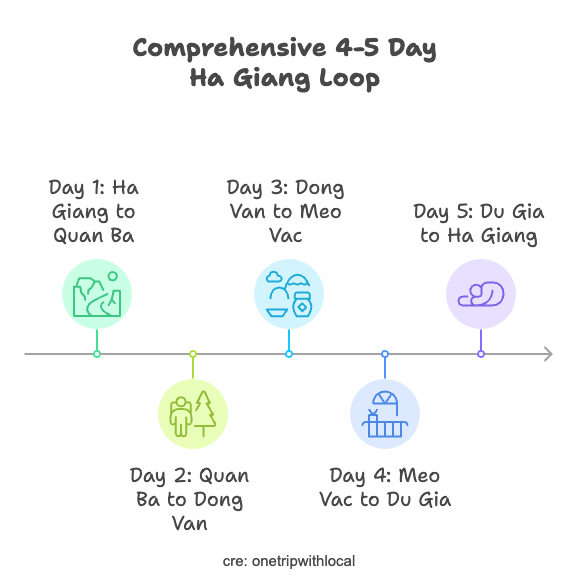
Day 1: Ha Giang to Quan Ba (50km, 2-3 hours)
- Morning: Leisurely departure from Ha Giang
- Stops:
- Lung Tam Linen Cooperative
- Tham Ma slope viewpoint
- Lunch: Local restaurant in Tam Son
- Afternoon: Explore Heaven’s Gate Pass area
- Accommodation: Tam Son homestay or Auberge de Quan Ba
- Evening: Sunset at Heaven’s Gate, dinner at homestay
Day 2: Quan Ba to Dong Van (90km, 4-5 hours)
- Morning: Depart for Yen Minh
- Stops:
- Yen Minh pine forest
- Pho Bang ancient village
- Lunch: Local restaurant in Pho Bang
- Afternoon:
- Sa Phin Valley (Hmong King Palace)
- Lung Cu Flag Tower (17km detour)
- Accommodation: Hoa Cuong Hotel or local homestay in Dong Van
- Evening: Explore Dong Van Old Quarter, try local food
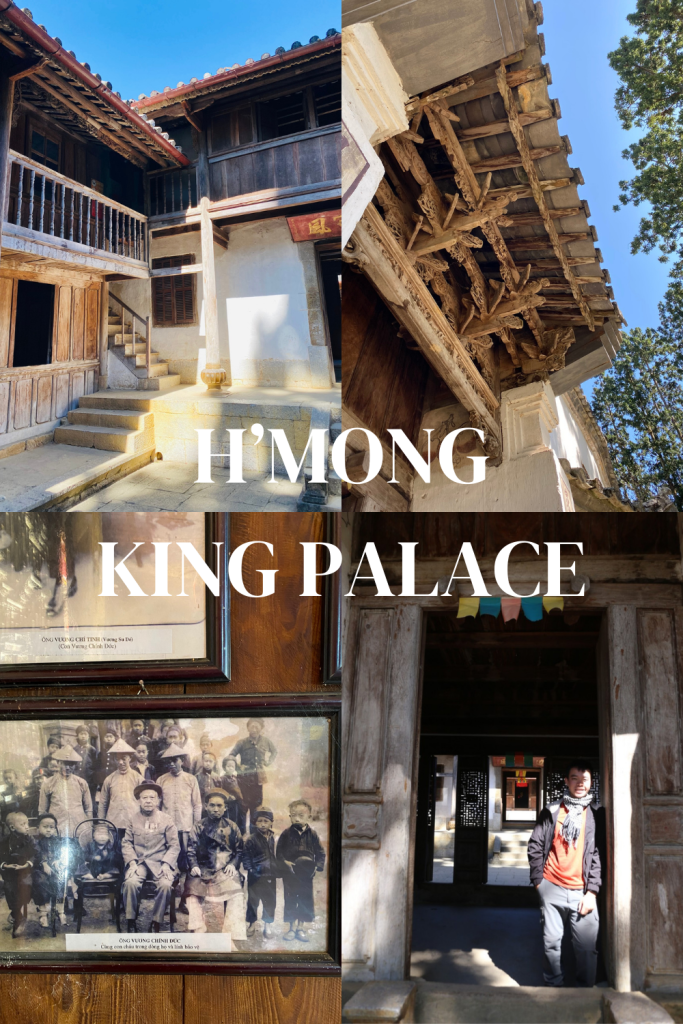
Day 3: Dong Van to Meo Vac (via Ma Pi Leng) (25km, 1-2 hours + exploration)
- Morning:
- Dong Van Sunday Market (if Sunday)
- Coffee at Coffee 1954 (mountain view)
- Mid-morning: Ma Pi Leng Pass with multiple photo stops
- Highlight: Panorama viewpoints along Ma Pi Leng
- Lunch: Tu San Canyon viewpoint restaurant
- Afternoon: Nho Que River boat tour
- Accommodation: Auberge de Meo Vac or local homestay
- Evening: Relax in Meo Vac
Day 4: Meo Vac to Du Gia (90km, 4-5 hours)
- Morning: Explore Meo Vac market
- Stops:
- Khau Vai Love Market village
- Remote Hmong villages off main road
- Lunch: Roadside restaurant
- Afternoon: Scenic drive to Du Gia
- Accommodation: Du Gia Homestay or QT Hostel
- Evening: Visit Du Gia waterfall, dinner with local family
Day 5: Du Gia to Ha Giang (70km, 3-4 hours)
- Morning: Relaxed breakfast, village walk
- Stops:
- Tay minority villages
- Lung Tam craft village
- Lunch: Local restaurant en route
- Afternoon: Return to Ha Giang
- Evening: Celebratory dinner in Ha Giang city
Benefits of this extended itinerary:
- Much more relaxed pace
- Time for spontaneous discoveries
- Better photography opportunities
- Deeper cultural immersion
- Less physical fatigue
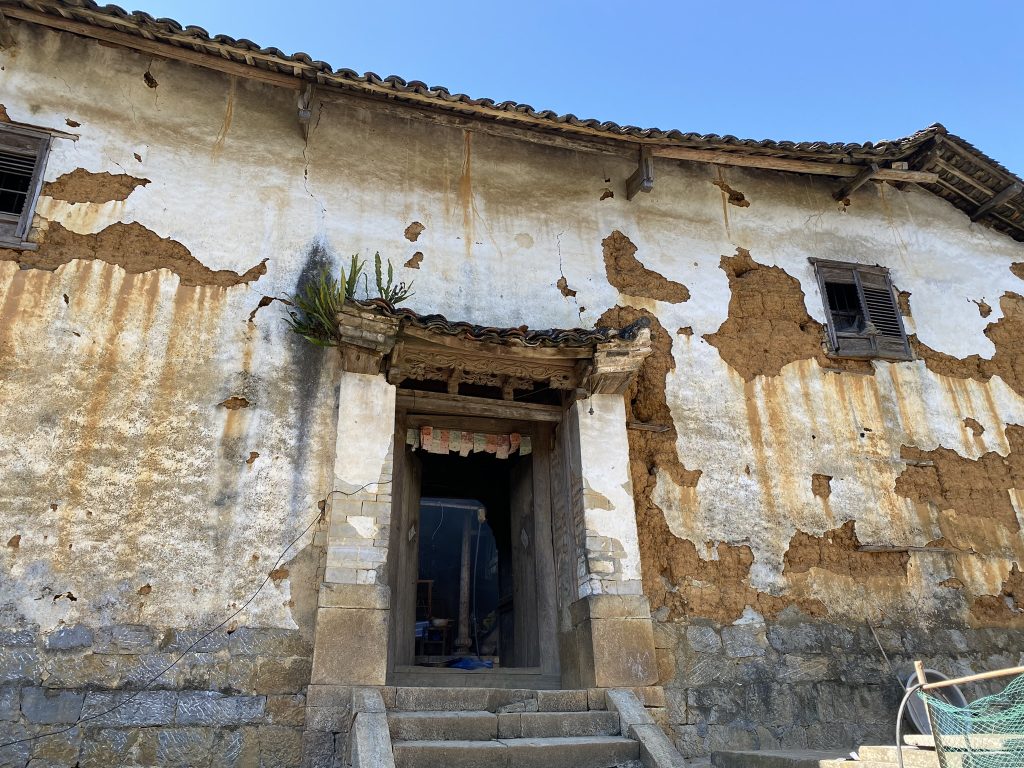
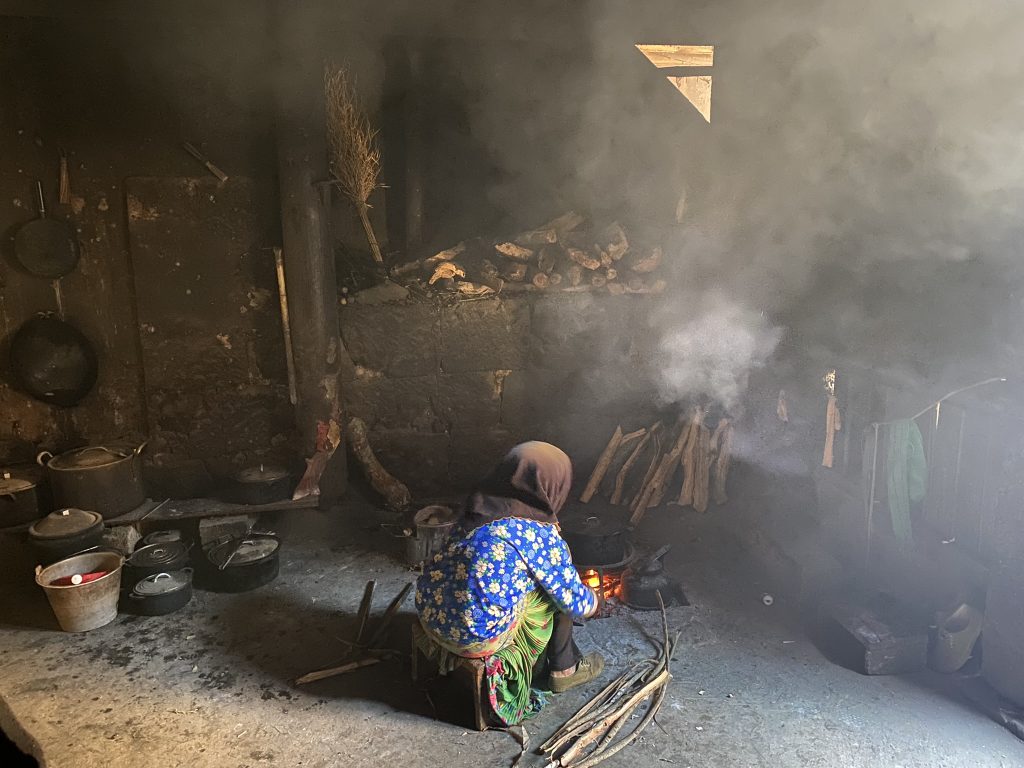
3. Specialized Itineraries: Photography, Culture, and Adventure
Photography-Focused 5-Day Itinerary This variation prioritizes optimal lighting and composition opportunities.
Key adaptations:
- Start early for morning light at key vistas
- Plan for golden hour at major viewpoints
- Extend time at Ma Pi Leng Pass for varied lighting conditions
- Include Lung Cu Tower for panoramic shots
- Add Nam Dam village for cultural photography
- Schedule flexibility for weather changes
- Overnight in locations with sunset/sunrise potential
Optimal photography locations and timing:
- Heaven’s Gate: Early morning or late afternoon
- Ma Pi Leng Pass: Morning (9-11am) for best light
- Nho Que River: Mid-day for vibrant turquoise color
- Dong Van Plateau: Early morning for misty landscapes
- Local markets: Early morning for authentic activity
Cultural Immersion 5-6 Day Itinerary This variation emphasizes ethnic minority experiences and traditions.
Key highlights:
- Sunday markets: Plan to hit Dong Van or Meo Vac on Sunday
- Homestay focus: Choose family-run homestays over hotels
- Cooking classes: Arrange traditional meal preparation
- Craft villages: Extended time in textile and artisan communities
- Festival timing: Research seasonal events and ceremonies
- Local guide: Arrange village guides for deeper insights
Cultural hotspots:
- Lung Tam: Hmong textile cooperative
- Sa Phin: Traditional Hmong architecture
- Pho Bang: Chinese-influenced ancient town
- Nam Dam: Traditional Dao village
- Pa Vi: Remote Lo Lo minority village
Adventure 4-Day Itinerary For thrill-seekers wanting to add hiking and more adventurous elements.
Key elements:
- Tu San Canyon trek: Half-day hike to canyon floor
- Lung Cu peak hike: Alternative path to summit
- Off-road sections: Dirt paths to remote villages
- Ma Pi Leng hiking trail: Recently developed trail with extreme views
- Waterfall swimming: Natural pools in Du Gia
When visiting the cultural sites in Ha Giang, you’ll gain a deep appreciation for Vietnam’s diverse traditions. For those interested in cultural immersion, our Hanoi French Quarter Tour makes an excellent complement to your Ha Giang adventure, showing the stark contrast between Vietnam’s colonial history and traditional cultur
Chapter 5:
Must-Visit Destinations on the Ha Giang Loop
In this chapter, we highlight the most breathtaking stops you simply can’t miss.
Here’s what’s waiting for you:
- Ma Pi Leng Pass – The most spectacular mountain road in Vietnam
- Lung Cu Flag Tower – Stand at the northernmost point of the country
- Dong Van Karst Plateau – A stunning UNESCO-listed geopark
- Nho Que River & Tu San Canyon – Glide through turquoise waters in a hidden canyon
- Authentic village experiences – Meet the locals and immerse in ethnic cultures
These are the places that make the Ha Giang Loop truly unforgettable. Let’s explore them one by one!
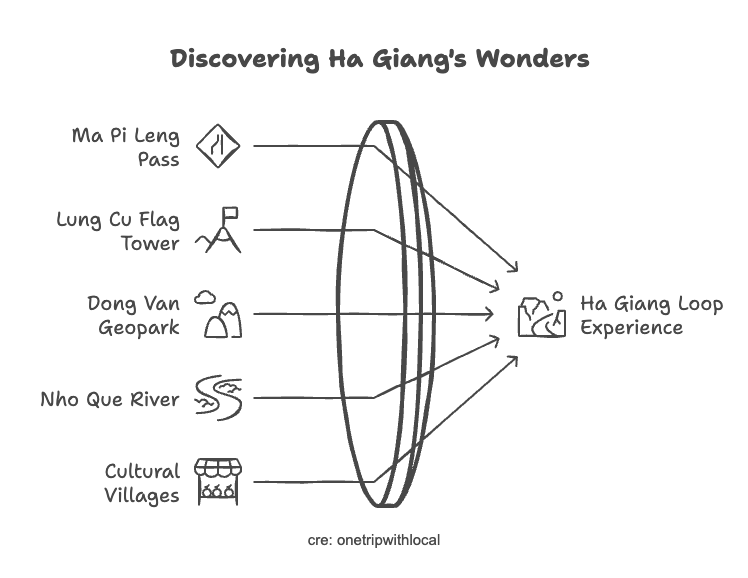
1. Ma Pi Leng Pass: Vietnam’s Most Spectacular Mountain Road
Ma Pi Leng Pass is the undisputed crown jewel of the Ha Giang Loop. This 20-kilometer stretch between Dong Van and Meo Vac delivers Vietnam’s most dramatic mountain scenery.
The name “Ma Pi Leng” means “bridge of a horse’s nose” in the Hmong language, referring to the narrow ridgeline. Construction began in the 1960s, with workers dangling from ropes to carve this engineering marvel into near-vertical cliffs.
The pass reaches an elevation of 1,500 meters, with the road dramatically clinging to limestone cliffs that plunge almost 800 meters down to the Nho Que River. The turquoise river creates a stunning contrast against the grey karst landscape.
Key viewpoints include:
- Ma Pi Leng Panorama: Official viewing platform (small entrance fee)
- Skywalk Viewpoint: Newer platform with 360° views
- Pa Vi Lookout: Less visited spot with wide vistas
- Heaven’s Gate café: Stunning river views with refreshments
Photography tips:
- Morning light (8-10am) illuminates the valley best
- Wide-angle lenses capture the scale
- Panorama mode for the sweeping vistas
- Include the winding road in compositions for scale
Safety considerations:
- Extremely narrow in sections with limited guardrails
- Pull over only in designated viewpoints
- Watch for falling rocks after rain
- Strong winds can affect motorcycle stability
Controversy note: The original Ma Pi Leng Panorama café was built without proper permits and partially demolished in 2019. The rebuilt structure is more environmentally appropriate.
2. Lung Cu Flag Tower: Standing at Vietnam’s Northern Frontier
Lung Cu Flag Tower marks Vietnam’s northernmost point, sitting just 3 kilometers from the Chinese border. This patriotic landmark features a massive Vietnamese flag (54 square meters) flying atop a 30-meter tower.
The tower stands on Dragon Mountain (Lồng Cú) at an elevation of 1,700 meters. On clear days, you can see into China’s Yunnan province from the summit.
Visiting information:
- Entrance fee: 25,000 VND ($1.10)
- Opening hours: 7am-5pm daily
- Climbing: 140 steps to the top
- Time required: 1-2 hours including travel time from Dong Van
The experience:
- Climb the spiral staircase inside the tower
- 360-degree views from the observation deck
- Photo opportunities with the massive flag
- Small museum explaining the border region’s significance
Cultural context: The site holds deep patriotic importance for Vietnamese visitors. The tower symbolizes national sovereignty, particularly significant given the complex historical relationship with China. Respectful behavior is appreciated.
Getting there: Located 24km north of Dong Van, the detour takes about 1 hour round-trip. The road is well-paved but winding. Consider combining with a visit to Lo Lo ethnic villages nearby.
3. Dong Van Karst Plateau Geopark: UNESCO-Recognized Landscape
The entire Ha Giang Loop traverses the Dong Van Karst Plateau Geopark, designated a UNESCO Global Geopark in 2010. This 2,356 square kilometer area contains some of Vietnam’s most scientifically and culturally significant landscapes.
Geological significance:
- Ancient limestone formations: 400-600 million years old
- Dramatic karst topography: Formed through erosion over millennia
- Fossil-rich environment: Containing prehistoric marine fossils
- Complex cave systems: Many still unexplored
Key viewing locations:
- Quan Ba Heaven’s Gate: Gateway to the plateau
- Dong Van Plateau viewpoint: Near km marker 116
- Tu San Canyon: Asia’s deepest canyon at 800+ meters
- Sa Phin Valley: Unusual limestone formations
Cultural adaptations: What makes this geopark unique is how ethnic minority groups have adapted to this challenging terrain:
- Rocky field agriculture using stone walls
- Water conservation systems capturing scarce rainfall
- Cave dwellings in some areas
- Unique agricultural techniques for limestone soil
The landscape has directly shaped the cultures inhabiting it, creating a rare harmony between geological features and human adaptation.
Visitor information:
- The Geopark Information Center in Dong Van provides educational displays
- Local guides can be arranged for deeper geological explanation
- Photography is particularly stunning in early morning or late afternoon light
- Several marked viewpoints provide educational signage about formation processes
4. Nho Que River and Tu San Canyon: Turquoise Beauty
The Nho Que River carves through the mountains with a distinctive turquoise-green color that creates a mesmerizing contrast against the grey limestone. This river flows through Tu San Canyon, which at over 800 meters deep is considered the deepest canyon in Southeast Asia.
Boat tour experience:
- Location: Accessible via a steep path from Ma Pi Leng Pass
- Cost: 100,000-150,000 VND ($4.50-6.50) per person
- Duration: 30-45 minutes
- Experience: Traditional boats navigate the river canyon
- Views: Unique perspective looking up at the towering cliffs
- Booking: Available on-site, no advance reservation needed
Photography vantage points:
- Ma Pi Leng Pass viewpoints: Looking down on the river
- River level: Looking up from the boats
- Tu San Bridge: Western view of the canyon
- Pa Vi Viewpoint: Less visited eastern perspective
Hiking alternatives: For the adventurous, a hiking trail descends to the river. It’s steep and challenging but rewarding:
- Trail access: Near the Ma Pi Leng Panorama
- Duration: 45-60 minutes down, 60-90 minutes up
- Difficulty: Moderate to difficult, proper footwear required
- Reward: Swimming in certain areas (check local guidance for safety)
Historical significance: The river forms part of the natural border with China in sections. It has historically been an important trade route and remains culturally significant to local ethnic groups who consider certain sections sacred.
5. Cultural Immersion: Villages and Local Life
The Ha Giang Loop passes through territories of numerous ethnic groups, each with distinct cultural traditions. Here are key cultural experiences:
Key ethnic minority villages:
- Lung Tam (Hmong): Famous textile cooperative where you can watch traditional linen making
- Nam Dam (Dao): Well-preserved village with traditional indigo dyeing
- Pho Bang (Chinese influence): Historic trading town with unique architecture
- Sa Phin (Hmong): Home to the restored Hmong King Palace
- Pa Vi (Lo Lo): Colorful traditional clothing and distinctive houses
- Khau Vai (mixed): Known for the “love market” festival
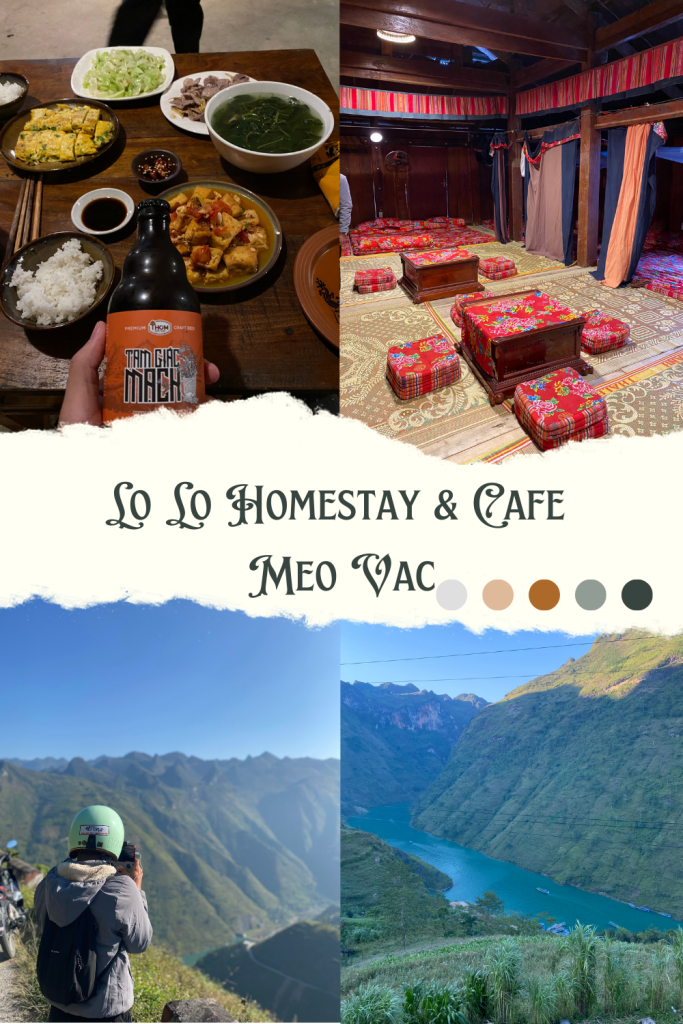
Market schedules:
- Dong Van: Sunday mornings (largest and most famous)
- Meo Vac: Sunday mornings
- Yen Minh: Wednesday and Saturday
- Tam Son (Quan Ba): Saturday
- Lung Tam: Thursday
Markets begin early (6am) and typically wind down by noon.
Ethical photography guidelines:
- Always ask permission before photographing people
- Offer to show people their photos on your camera screen
- Consider purchasing small items if photographing vendors
- Avoid photographing religious ceremonies without permission
- Be especially respectful with children
Interaction opportunities:
- Learn basic greetings in Hmong or Dao languages
- Purchase directly from artisans (textiles, silverwork, embroidery)
- Participate in communal dinners at homestays
- Ask about local festivals and celebrations
- Try local specialties like thắng cố (traditional horse meat stew)
Homestay experiences: Homestays offer the deepest cultural immersion. Most include:
- Accommodation in traditional houses
- Family-style dinner and breakfast
- Rice wine sharing ritual
- Cultural exchange despite language barriers
- Insight into daily rural life
Community-based tourism initiatives: Several villages have organized to provide authentic experiences while ensuring tourism benefits go directly to communities:
- Action for Ha Giang’s Development: Supporting sustainable tourism initiatives
- Ethos: Organization connecting travelers with authentic homestays
- Responsible Travel Vietnam: Education on ethical tourism practices
While experiencing these traditional villages, you’ll gain perspective on Vietnam’s cultural diversity. For food enthusiasts interested in culinary traditions, our Hanoi Street Food Tour provides an excellent introduction to Vietnamese cuisine before your mountain adventure.
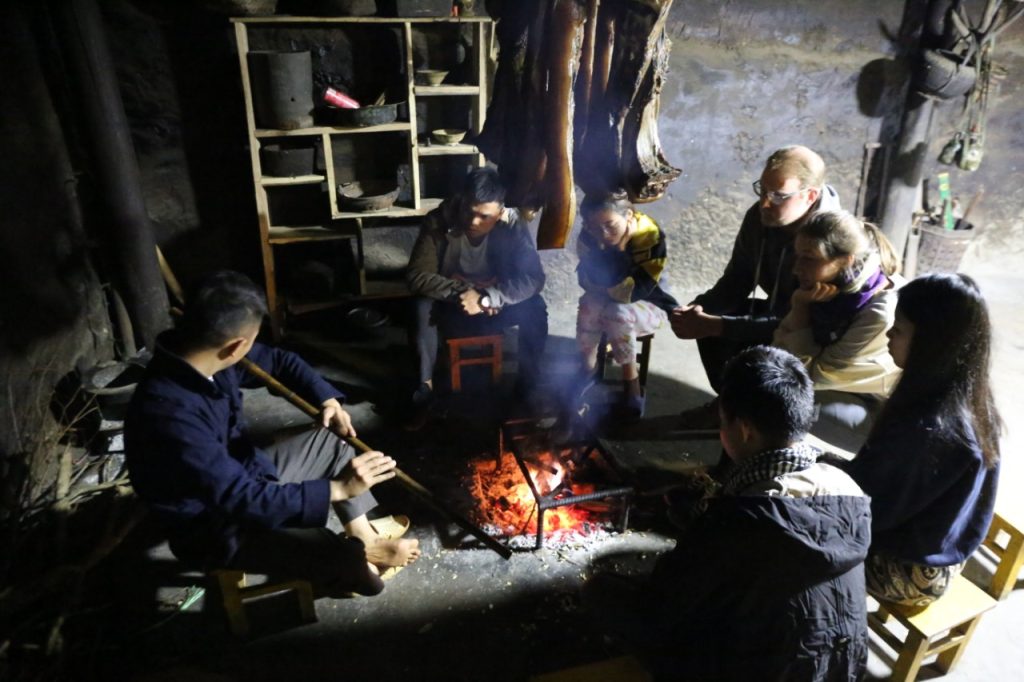
Chapter 6:
Practical Guide to the Ha Giang Loop
A successful Ha Giang Loop adventure isn’t just about the ride—it’s about being prepared. From where to stay to what to pack, this chapter covers all the essentials to ensure a smooth and stress-free journey.
Here’s what you’ll find:
- The best accommodation options along the loop—from cozy homestays to convenient hostels
- A must-have packing list to keep you safe, comfortable, and ready for any challenge
- Tips on navigation and communication to help you stay on track and connected
Don’t leave anything to chance—read on to make sure you’re fully prepared for the ride of a lifetime!
1. Accommodation Options Along the Loop
Accommodation options have expanded significantly in recent years, though advance booking is still recommended during peak seasons.
Ha Giang City:
- Budget: Creekside Hostel ($5-8 dorm), Hi Giang Hostel ($6-9 dorm)
- Mid-range: Phoenix Hotel ($20-30), Cao Nguyen Hotel ($25-35)
- Comfort: Huy Hoan Hotel ($40-50), River Queen Hotel ($45-60)
- Features: Starting point amenities, bike rentals, tour information
Quan Ba/Tam Son:
- Homestays: Heaven’s Gate Homestay ($10-15), Nam Dam Homestay ($12-18)
- Guesthouses: Tam Son Guesthouse ($15-25), Quan Ba Hotel ($20-30)
- Highlight: Traditional Tay-style houses with mountain views
Yen Minh:
- Budget: Rocky Plateau Backpackers ($8-12), Thang Co Homestay ($10-15)
- Mid-range: Thien Nga Hotel ($20-30), Hong Cam Hotel ($25-35)
- Features: Halfway point on day one, basic amenities
Dong Van:
- Budget: Dong Van Backpackers ($8-12), Xuan Thu Guesthouse ($15-20)
- Mid-range: Hoa Cuong Hotel ($25-35), Cao Nguyen Hotel ($30-40)
- Comfort: Dong Van Rocky Plateau Hotel ($45-60)
- Features: Old Quarter location, weekend market access
Meo Vac:
- Budget: Meo Vac Hostel ($8-12), Auberge de Meo Vac ($12-18)
- Mid-range: Hai Quan Hotel ($20-30), Meo Vac Clay House ($35-45)
- Homestays: QT Homestay ($12-15), Meo Vac Family Homestay ($10-15)
- Features: Traditional architecture, spectacular views
Du Gia:
- Homestays: Du Gia Homestay ($10-15), QT Du Gia ($12-18)
- Features: Communal dining, waterfall access, authentic village experience
Booking strategies:
- Peak season (Oct-Dec): Book 2-3 days in advance
- Off-season: Same-day booking usually possible
- Platforms: Booking.com and Agoda have most options
- Direct booking: Often possible via WhatsApp/Facebook
- Tour arrangement: Most bike rental shops can book accommodation
Homestay experience expectations:
- Shared sleeping areas on mattresses with mosquito nets
- Shared bathrooms (usually clean but basic)
- Family-style dinner included (often excellent local cuisine)
- Breakfast included (typically pho or rice)
- Cultural exchange despite potential language barriers
2. Essential Packing List for Ha Giang Loop Success
Motorcycle-specific gear:
- Helmet: Rental helmets vary in quality; bring your own if possible
- Riding gloves: Protect hands and improve grip
- Sunglasses/clear glasses: Eye protection from insects and dust
- Bandana/buff: For dust and pollution protection
- Waterproof backpack cover: Essential for rainy conditions
- Bungee cords: Secure luggage to motorcycle
- Phone mount: For navigation visibility (under $10 in Hanoi shops)
Weather-appropriate clothing:
- Layering options: Temperature varies with elevation and time of day
- Lightweight rain jacket: Even in dry season, prepare for showers
- Quick-dry clothing: Humidity makes cotton uncomfortable
- Warm layer: Evenings can be cool, especially October-March
- Sun hat: Protection during stops
- Comfortable shoes: For village exploration
- Swimwear: For Nho Que River or waterfall opportunities
Technology essentials:
- Power bank: Limited charging opportunities in remote areas
- Camera equipment: Extra batteries and memory cards
- Waterproof phone case: Protection from rain
- Offline maps: Download before departure
- Portable chargers: Some homestays have limited outlets
Health and first-aid:
- Personal medications: Bring extra supply
- Basic first-aid kit: Bandages, antiseptic, pain relievers
- Motion sickness medication: Winding roads challenge sensitive stomachs
- Sunscreen: High altitude increases burn risk
- Insect repellent: Especially during summer months
- Hand sanitizer: Limited handwashing facilities en route
- Toilet paper: Not always provided in remote restrooms
Cultural considerations:
- Modest clothing: For village visits and homestays
- Light, removable shoes: Many homestays request removing shoes
- Small gifts: Optional but appreciated for homestay hosts (fruit, sweets)
Weight limitations: Remember that everything must be carried on your motorcycle. Pack light, focusing on essentials. Most people manage with a 30-40L backpack maximum.
3. Navigation and Communication on the Loop
Offline map recommendations:
- Maps.me: Most detailed offline mapping for the region
- Google Maps: Download “Northern Vietnam” offline area
- Vietnam Coracle: Website with detailed route descriptions (save offline)
- Gaia GPS: Excellent topographic detail for adventure variants
Mobile network coverage realities:
- Viettel: Best coverage in remote areas (recommended)
- Vinaphone: Good coverage in towns, spotty between
- Mobifone: Least reliable in mountain regions
- Coverage gaps: Expect no signal for 1-2 hour stretches
- Homestay/hotel WiFi: Available but often slow
Essential Vietnamese phrases:
- Xin chào: Hello
- Cảm ơn: Thank you
- Bao nhiêu tiền?: How much?
- Nhà vệ sinh ở đâu?: Where is the bathroom?
- Tôi bị lạc đường: I am lost
- Xin giúp tôi: Please help me
- Tôi cần sửa xe máy: I need motorcycle repair
Navigation strategies:
- Screenshot directions: Before leaving WiFi
- Mark key waypoints: Hotels, viewpoints, gas stations
- Use physical map: As backup to electronic navigation
- Follow road signs: Main attractions are well-marked
- Ask locals: Most are helpful despite language barriers
Communication strategies for groups:
- Set meeting points: In case of separation
- Establish visual signals: For road hazards or stops
- Maintain visual contact: Front rider responsible for keeping group together
- Predetermined stops: Agree on regrouping locations in advance
Chapter 7:
Staying Safe on the Ha Giang Loop
In this chapter, we’ll cover:
- Road safety tips to navigate sharp turns and unpredictable conditions
- Health and medical precautions to stay fit and prepared for emergencies
- Personal safety advice for solo travelers and group riders
- Essential emergency contacts in case you need assistance on the road
Stay informed, ride with confidence, and make safety a priority.
Let’s dive in!
1. Road Safety
The Ha Giang Loop presents some of Vietnam’s most challenging driving conditions. Take these dangers seriously:
Road hazards to be aware of:
- Blind corners: Hundreds of hairpin turns with limited visibility
- Sheer drops: Many sections lack guardrails with 100+ meter drops
- Livestock: Buffalo, goats, and dogs frequently cross roads
- Trucks and buses: Take up entire road width on curves
- Loose gravel: Particularly dangerous on steep sections
- Road construction: Ongoing improvements mean frequent delays
- Landslides: Common during/after rain
Safe driving practices:
- Maintain moderate speed: 30-40 km/h maximum on mountain sections
- Horn before blind corners: Local practice to alert oncoming traffic
- Right-side driving: Stay far right on blind corners
- Braking technique: Use both brakes gently, avoid front-brake-only
- Overtaking protocol: Only with clear visibility, use horn to signal
- Weather adaptation: Reduce speed by 50% in rain or fog
- Rest frequently: Driver fatigue causes accidents
Seasonal considerations:
- Rainy season (May-September): Increased landslide risk, slippery surfaces
- Winter (December-February): Morning fog reduces visibility, occasional ice
- High season (October-November): Heavier traffic requires extra caution
In case of accident:
- Emergency number: 115 (ambulance), 113 (police)
- Nearest hospitals: Ha Giang General Hospital, Dong Van District Hospital
- Procedure: Document scene with photos, obtain police report for insurance
- Local assistance: Most Vietnamese will stop to help foreigners in need
Equipment checks:
- Brake test: Before departing and each morning
- Tire pressure: Especially important for mountain roads
- Lights working: Required for tunnels and poor visibility
- Horn functioning: Essential safety feature on mountain roads
2. Health and Medical
Travel insurance requirements:
- Coverage that includes motorcycle riding: Many policies exclude this
- Providers that cover motorcycles: World Nomads (specific plan), SafetyWing
- Minimum recommended coverage: $100,000 medical, evacuation coverage
- Policy verification: Confirm motorcycle coverage in writing before departure
First-aid essentials:
- Pain relievers: Ibuprofen, paracetamol
- Bandages and gauze: For minor injuries
- Antiseptic wipes: Wound cleaning
- Rehydration salts: For dehydration or food issues
- Anti-diarrheal medication: Remote areas have limited facilities
- Personal prescriptions: Bring extra supply
- Motion sickness medication: Winding roads challenge sensitive stomachs
Medical facilities along the loop:
- Ha Giang General Hospital: Most comprehensive facility (international department)
- Dong Van District Hospital: Basic care, limited English
- Meo Vac Medical Center: Emergency treatment only
- Pharmacies: Available in all towns for basic supplies
- Serious emergencies: Evacuation to Hanoi required (6+ hours)
Common health concerns:
- Dehydration: Mountain sun is intense, drink 3-4 liters daily
- Sunburn: High altitude increases UV exposure
- Food safety: Stick to freshly cooked, hot foods in remote areas
- Altitude effects: Some passes exceed 1,500m, acclimatize slowly
- Exhaustion: Physical demands of riding are significant
Vaccinations to consider:
- Routine vaccinations: Ensure these are up-to-date
- Hepatitis A and Typhoid: Recommended for Vietnam
- Tetanus: Important for any adventure travel
- Japanese Encephalitis: Consider for rural areas in rainy season
3. Personal Safety
The Ha Giang region is generally very safe for travelers, with minimal crime. However, sensible precautions include:
General safety tips:
- Valuable storage: Use hotel safes when available
- Motorcycle security: Use locks, park in designated areas
- Cash management: Carry small denominations, divide money between locations
- Bag security: Keep backpacks in front while in markets
- Nighttime precautions: Carry a flashlight, streets poorly lit
- Alcohol moderation: Roads require clear judgment
Ha Giang-specific considerations:
- Border area regulations: Some areas require permits (arranged by hotels)
- Photography sensitivity: Military installations should never be photographed
- Cultural respect: Conservative dress in villages, ask before photographing people
- Weather awareness: Conditions change rapidly in mountains
4. Emergency Contacts
Save these numbers before departure:
- Vietnam emergency: 113 (police), 115 (ambulance), 114 (fire)
- Ha Giang Tourist Police: +84 219 3867 737
- Your country’s embassy in Hanoi: [Contact details vary]
- Your accommodation contacts: Save these daily
- Your motorcycle rental contact: For breakdown assistance
Offline access: Write down essential numbers on paper backup
Chapter 8:
Food and Drink on the Ha Giang Loop
The Ha Giang Loop isn’t just a feast for the eyes—it’s a chance to indulge in the unique flavors of the region. From hearty mountain meals to refreshing local drinks, knowing what to eat (and where) will make your journey even more enjoyable.
In this chapter, you’ll discover:
- Local specialties – Must-try dishes and traditional flavors unique to Ha Giang
- Dietary considerations – Tips for vegetarians, picky eaters, and those with food allergies
Whether you’re sharing a home-cooked meal at a village homestay or grabbing a quick bowl of pho on the road, every bite is part of the adventure. Let’s dig in!
Local Specialties
Ha Giang’s cuisine reflects its ethnic diversity and mountain environment. Must-try dishes include:
Thắng Cố (Hmong Stew)
- Description: Traditional Hmong slow-cooked stew using horse or beef and 12+ herbs
- Experience: Strong flavor, cultural significance
- Where to try: Dong Van and Meo Vac restaurants
- Price: 70,000-120,000 VND ($3-5.50)
Buckwheat Products
- Description: Noodles, cakes, and wine made from local buckwheat
- Specialties: Bánh tam giác mạch (buckwheat cake)
- Where to try: Dong Van market, roadside stalls
- Price: 10,000-30,000 VND ($0.45-1.30)
Mountain Bee Honey
- Description: Rich, dark, wildflower honey from mountain bees
- Experience: Unique flavor profile from diverse high-altitude flowers
- Where to buy: Local markets, direct from producers
- Price: 100,000-200,000 VND ($4.50-9) per small bottle
Au Tau Porridge (Cháo Ấu Tẩu)
- Description: Medicinal rice porridge with local herbs
- Cultural significance: Traditional health food
- Where to try: Specialized shops in Dong Van
- Note: Contains au tau root, eaten in small quantities
Corn Wine (Rượu Ngô)
- Description: Potent distilled alcohol made from local corn
- Cultural significance: Served at all celebrations
- Experience: Often shared in homestays
- Strength: Very strong (45-55% alcohol)
Black Chicken (Gà Đen)
- Description: H’mong black chicken, free-range and distinctive flavor
- Preparation styles: Grilled, steamed with herbs, or in soup
- Where to try: Homestays often serve this for dinner
- Price: 150,000-250,000 VND ($6.50-11) for whole chicken
Authentic food experiences:
- Local markets: Best early morning for freshest options
- Homestay meals: Most authentic, family recipes
- Roadside stalls: Look for crowds of locals
- Town restaurants: Larger selection but sometimes adapted for tourists
If you’re interested in Vietnamese cuisine, our Hanoi Vegetarian Food Tour offers an excellent introduction to authentic dishes before your mountain adventure.
Dietary Considerations
Vegetarian and vegan options:
- Communication phrase: “Tôi ăn chay” (I eat vegetarian)
- Reliable options: Tofu dishes, morning glory, steamed rice
- Challenges: Rural areas have limited understanding of veganism
- Recommended approach: Homestays can accommodate with advance notice
- Self-catering: Fresh produce available at markets
Allergies and food sensitivities:
- Preparation: Written allergy card in Vietnamese
- Common challenges: Fish sauce in many dishes, shared cooking oil
- Communication phrase: “Tôi bị dị ứng với…” (I am allergic to…)
- Gluten-free: Rice noodles and rice widely available
- Preparation methods: Limited understanding of cross-contamination
Chapter 9:
Beyond the Loop: Extending Your Northern Vietnam Adventure
Finished the Ha Giang Loop but still craving more adventure? Northern Vietnam has even more breathtaking landscapes and cultural experiences waiting for you. Extend your journey and explore beyond the loop!
In this chapter, we’ll cover:
- How to combine Ha Giang with Sapa for the ultimate mountain experience
- Traveling from Ha Giang to Cao Bang to witness the majestic Ban Gioc Waterfall
From misty peaks to cascading falls, these add-ons will take your Vietnam adventure to the next level. Let’s explore your next destination!
Combining Ha Giang with Sapa: Mountain Highlights
Ha Giang vs Sapa? This common question has a simple answer: they offer complementary experiences worth combining if time allows.
Comparative analysis:
- Landscapes: Ha Giang features dramatic karst mountains; Sapa offers terraced rice fields
- Development: Ha Giang remains raw; Sapa has more tourism infrastructure
- Cultural experiences: Ha Giang offers more authentic minority encounters; Sapa has more commercialized cultural presentations
- Activities: Ha Giang excels for motorbiking; Sapa specializes in trekking
- Accessibility: Sapa has train connections; Ha Giang requires road transport
Logistics of connection:
- Direct route: Ha Giang to Sapa (215km, 6-7 hours)
- Transport options: Private car (2,500,000-3,500,000 VND/$110-150), public bus with transfer (300,000-400,000 VND/$13-17)
- Recommended sequence: Sapa first, then Ha Giang (easier acclimatization)
Combined itinerary suggestion (10 days):
- Days 1-3: Hanoi to Sapa, trekking adventures
- Day 4: Transport to Ha Giang
- Days 5-9: Ha Giang Loop (relaxed pace)
- Day 10: Return to Hanoi
Unique aspects of each destination:
- Sapa strengths: Established trekking routes, famous terraces, comfortable accommodations
- Ha Giang strengths: Authentic cultural encounters, dramatic roads, adventure feeling
Ha Giang to Cao Bang: Ban Gioc Waterfall Connection
For travelers with two weeks available, combining Ha Giang with Cao Bang province creates the ultimate northern Vietnam circuit.
Route options:
- Direct route: Meo Vac to Cao Bang city (190km, 6-7 hours)
- Scenic route: Via Bao Lac and Nguyen Binh (230km, 7-8 hours)
- Alternative: Return to Ha Giang first, then to Cao Bang (longer but easier roads)
Cao Bang highlights:
- Ban Gioc Waterfall: Vietnam’s most spectacular waterfall on Chinese border
- Nguom Ngao Cave: Massive cave system with impressive formations
- Pac Bo Cave: Historical site where Ho Chi Minh returned to Vietnam
- Phong Nam Valley: Scenic agricultural valley
- Trung Khanh: Ancient stone citadel
Extended itinerary recommendation (14 days):
- Days 1-5: Ha Giang Loop
- Day 6: Travel to Cao Bang city
- Days 7-9: Explore Ban Gioc and caves
- Days 10-11: Return via Lang Son
- Days 12-14: Halong Bay/Cat Ba extension
Permit requirements: Some border areas in Cao Bang require permits similar to Ha Giang. Most accommodations can arrange these, typically included with tours to Ban Gioc Waterfall.
Chapter 10:
FAQ about the Ha Giang Loop
Still have questions about the Ha Giang Loop? You’re not alone! Whether it’s about safety, logistics, or what to expect on the road, we’ve got you covered with the most frequently asked questions.
License Requirements for Riding in Ha Giang
Legal requirements:
- Vietnamese law requires an appropriate motorcycle license
- For foreigners, this means:
- A valid motorcycle license from your home country
- An International Driving Permit (IDP)
- Conversion to a Vietnamese license (for longer stays)
- A motorcycle endorsement on your license must match the engine size
Enforcement realities:
- Police checks occur primarily in Ha Giang city
- Rural areas have limited enforcement
- Penalties if stopped: 500,000-1,000,000 VND ($22-45) fine, possible vehicle impoundment
- Border zone permit checks are more common than license checks
Insurance implications:
- Critical point: Most travel insurance policies invalidate coverage for unlicensed riding
- Medical costs for serious accidents can exceed $10,000
- Some specialized insurance may cover regardless of license status
Alternatives for those without proper license:
- Easy Rider services with local drivers
- Private car hire with driver
- Joining organized tours
Is the Ha Giang Loop Dangerous?
Honest assessment: The Ha Giang Loop involves genuine risks that travelers should consider seriously:
- Road hazards: Extreme mountain terrain, sheer drops, frequent landslides
- Traffic dangers: Trucks on narrow roads, unpredictable local driving
- Weather risks: Sudden fog, heavy rain reducing visibility
- Remote location: Limited medical facilities, long evacuation times
Statistical context: While exact statistics aren’t published, local sources report several serious tourist accidents annually, primarily involving:
- Inexperienced riders attempting challenging sections
- Excessive speed on mountain roads
- Collisions with local vehicles on blind corners
Most challenging sections:
- Ma Pi Leng Pass: Steep drops, narrow sections
- Meo Vac to Du Gia road: Poor surface conditions
- Heaven’s Gate descent: Steep switchbacks
- China border roads: Rough surfaces, limited guardrails
Safety improvement strategies:
- Choose appropriate motorcycle for skill level
- Wear quality helmet and protective gear
- Maintain moderate speeds (30-40 km/h maximum)
- Start early to avoid riding after dark
- Check weather forecasts daily
- Consider Easy Rider for difficult sections
Expert advice: “The Ha Giang Loop is manageable for riders with some experience who respect the roads and their limitations. It’s not suitable for learning to ride or for those seeking high-speed thrills.” – Local tour guide with 9 years experience
What to Do in Bad Weather on the Ha Giang Loop
Weather changes rapidly in mountain environments. Be prepared with these strategies:
Weather contingency planning:
- Build buffer days into your itinerary
- Check forecasts daily using AccuWeather or Windy apps
- Start early to beat afternoon rain patterns
- Know alternate routes if primary roads close
Alternative activities during rain:
- Cultural museums: Available in Dong Van and Ha Giang city
- Covered markets: Explore local products and food
- Homestay activities: Many offer cooking classes or craft demonstrations
- Cafe waiting: Mountain weather often clears within hours
Safety procedures for adverse conditions:
- Pull over if visibility drops significantly
- Find shelter during electrical storms
- Avoid river crossings after heavy rain
- Watch for landslide warning signs (fresh earth on road)
- Reduce speed by 50% on wet roads
Seasonal weather patterns:
- October-April: Occasional fog, generally dry
- May-September: Afternoon thunderstorms common
- December-February: Morning fog, clearing midday
- Worst period: July-August (heaviest rain)
Equipment recommendations:
- Quality rain gear: Jacket and pants
- Waterproof bags/covers: For electronics and clothing
- Quick-dry clothing: Avoid cotton
- Plastic bags: For telephone during downpours
- Waterproof gloves: For comfortable riding
Ethical Travel Considerations for Ha Giang
Responsible tourism helps preserve what makes Ha Giang special:
Cultural respect guidelines:
- Dress modestly in villages (shoulders/knees covered)
- Ask permission before entering homes or taking photos
- Learn basic greetings in local languages
- Remove shoes when entering homes
- Follow local customs regarding gender roles in traditional contexts
Environmental sustainability:
- Carry out all trash – no waste disposal facilities in remote areas
- Avoid single-use plastics – bring reusable water bottle
- Stay on established paths when hiking
- Minimize noise pollution – rural communities value quiet
- Use biodegradable toiletries – water runs directly to fields
Economic impact consciousness:
- Support locally-owned businesses rather than chains
- Pay fair prices without excessive bargaining
- Purchase directly from artisans when possible
- Consider homestays over hotels to support families
- Hire local guides to distribute tourism benefits
Photography ethics:
- Always ask before photographing people
- Show them the results on your camera screen
- Avoid payment for photos – creates problematic dynamics
- Be especially sensitive with children
- No drone usage near border zones or without permission
Supporting community-based tourism:
- Action on Ha Giang Development: Local NGO supporting sustainable tourism
- QT Motorbikes community projects: Reinvests in educational initiatives
- Ethos Homestay Network: Ensures fair compensation to host families
Can I use US dollars in Ha Giang?
No. Unlike some tourist areas in Vietnam, Ha Giang operates almost exclusively with Vietnamese Dong (VND). Credit cards are rarely accepted outside Ha Giang city, and ATMs are limited to main towns. Bring sufficient Vietnamese Dong for your entire trip, particularly small denominations (10,000-100,000 VND notes).
Is it safe to drink the water?
No. Tap water is not potable throughout the region. Options include:
- Bottled water (widely available)
- Water purification tablets/devices
- Boiled water (provided at homestays)
What is the mobile phone coverage like?
Variable. Viettel network provides the best coverage but expect dead zones between towns. Download offline maps before departure. Communication apps like WhatsApp will work only with WiFi/data connection. Consider buying a local SIM card in Hanoi before departing.
Do I need to know Vietnamese?
Basic phrases help significantly but aren’t essential. In towns, some English is spoken in tourism businesses. In villages, communication relies more on gestures and translation apps. Having key phrases written down (addresses, allergies, basic needs) proves invaluable.
Chapter 11:
Conclusion
The Ha Giang Loop represents Vietnam at its most authentic and spectacular. The combination of jaw-dropping landscapes, living cultural traditions, and thrilling roads creates an experience that many travelers describe as life-changing.
While the journey requires preparation and respect for its challenges, the rewards are immeasurable. You’ll return with photographs that seem impossible, stories of encounters in remote villages, and memories of winding through clouds on mountain passes.
As tourism increases, the authentic character of Ha Giang faces inevitable change. Visit now, while the perfect balance of accessibility and authenticity remains.
Whether you choose a guided tour or independent adventure, travel responsibly to preserve what makes this region special. Respect local cultures, support community-based tourism, and tread lightly on this remarkable landscape.
The Ha Giang Loop isn’t just a motorbike route – it’s Vietnam’s most extraordinary adventure. When will you experience it?
I sincerely hope that you had an absolutely amazing and unforgettable experience exploring the Ha Giang loop, just like I did. It is truly an incredible and breathtaking journey that allows you to witness the stunning beauty of nature, immerse yourself in the vibrant local culture, and create memories that will last a lifetime. Whether it was the exhilarating motorbike ride through the winding mountain roads, the awe-inspiring views of the majestic mountains and terraced rice fields, or the warm and welcoming hospitality of the local people, I truly hope that every moment of your Ha Giang loop adventure was filled with joy, wonder, and a sense of awe.